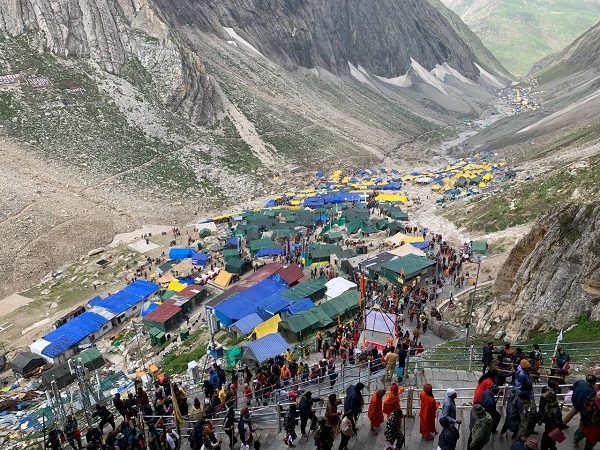
New Delhi, (Asian independent) Little more than a week after the tragic death of 16 pilgrims near the holy cave shrine of Amarnath on July 8, hundreds of devotees continue to trudge up the arduous treks from Pahalgam and Baltal side fighting their fears and inclement weather.
In fact, over 1.64 lakh yatris have so far performed the ongoing Amarnath yatra as of Saturday with or without being distracted by the tragedy that saw scores of pilgrims being washed away by or buried under a mud and sludge slide from a stream next to the cave as a result of massive rainfall on a hill behind the cave.
In the next two immediate days, much of the talk revolved around disaster management and incorrect weather predictions and the lacunae thereof. However, there was hardly any talk about restricting the number of pilgrims into the high altitude pilgrimage destinations such as Amarnath Cave shrine (Approximately 14,000 feet).
Fragile Himalayan destination
The holy cave shrine is situated at about 14,000 feet (3,888 metres) in the Kashmir Himalayas. The holy cave houses an ice stalagmite, symbolic of a Shiv Ling, while outside is a region pristine and home to glaciers and multiple snow-clad peaks. In fact, pilgrims need to cross snow tracks while in the last 5-6 kms stretch leading to the cave.
Environmentalists have time and again demanded a restriction on the numbers that visit such high altitude areas from where big and small glaciers and streams originate. But, not just Amarnath but scores of other destinations are witnessing large turnout of devotees with the government hardly making a move to consider the carrying capacity of the place.
“Prior monitoring of carrying capacity in terms of tourist inflow of vehicles, air quality and solid waste management largely in the Kashmir region for pilgrims visiting Shri Amarnath Ji holy cave and Mata Vaishnav Devi in Jammu need to be done to ensure quality tourism in the state (sic),” was one of the prominent recommendations of a recent report ‘Environmental Assessment of Tourism in the Indian Himalayan Region’ prepared by the Environment Ministry.
It is not that this cannot be done. A small yet most significant stretch beyond Gangotri town leading to the Gaumukh glacier is part of the Gangotri National Park. Since 2006, the number of persons crossing the Forest Department barrier beyond Gangotri pilgrim town has been restricted to 150 and that has worked wonders for the landscape violated by masses before it.
Amarnath had witnessed a similar but larger scale natural disaster in 1996. That time similar debates and questions were raised but soon forgotten.
Uttarakhand devastation in 2013 is a much recent example. Akash Vasishtha, an environmental lawyer, said the Amarnath deaths reminded him of the Supreme Court appointed Ravi Chopra Committee after the 2013 Uttarakhand disaster that had come out with a comprehensive report about the reasons for the massive scale of damage and loss of life.
“The very first and prominent reason of the disaster mentioned was not because of the extreme rainfall but that the extent and magnitude of the disaster got multiplied by the permanent structures that stood in the way of the river course,” Vasishtha said.
Exactly what had happened on July 8 near the cave. The tents pitched right in the path of rubble were either washed away or were buried under the debris that came with speed and volume down the narrow stream next to the cave. “It was totally an avoidable tragedy,” he said.
Anil U. Joshi, former Programme Director, Human Ability and Accessibility at IBM India Pvt Ltd., was part of the IBM team to help Uttarakhand government in reuniting families with the use of technology and de-duplicating the data for a fortnight in 2013.
“On the one hand, the Government of India and the National Disaster Management Authority (NDMA) keep talking / harping about disaster mitigation, but we don’t want to learn from previous experiences. We commit the same mistakes and later, when things go out of hands, promptly furnish incorrect figures, with confidence and authority to hide failures,” said Joshi, who is also active in coordination of pilgrims that head for Kailash Mansarovar Yatra — a three week pilgrimage through a snaking trek in Uttarakhand — for a decade now.
But then, who will bell the cat?
Joshi himself has been to Amarnath Yatra and the Kailash Mansarovar Yatra. “My observation is that no serious thought is given to the safety of yatris during the Amarnath Yatra unlike the Kailash Mansarovar Yatra where it’s done perfectly. Every single yatri is tracked daily! Evacuation, that too partial and only when necessary, is not going to address the challenge,” he added.
Rajeev Bansal, media coordinator of Paryavaran Sanrakshan Gatividhi (PSG), a recently formed body under the RSS patronage, said the Amarnath numbers were obviously very large this year as the Yatra was opened after a two year gap due to the pandemic.
Bansal agreed that in view of the damage inflicted on the environment, there should ideally be a limited use of natural resources with the ‘Reduce, Refuse, and Recycle’ principle. “Simply means, if not necessary, avoid doing it, means, refuse. But people lack awareness and in the case of examples such as Amarnath Yatra, people are tradition driven and most of them are not aware of their responsibility towards the environment.”
Agreeing that a restriction on numbers beyond a particular altitude is necessary in the Himalayas, Bansal said: “Why just Amarnath, there was also a talk about restricting pilgrims at Vaishno Devi too. But it will be difficult for the government to do it. It needs participation from the community to arrive at that decision.”







